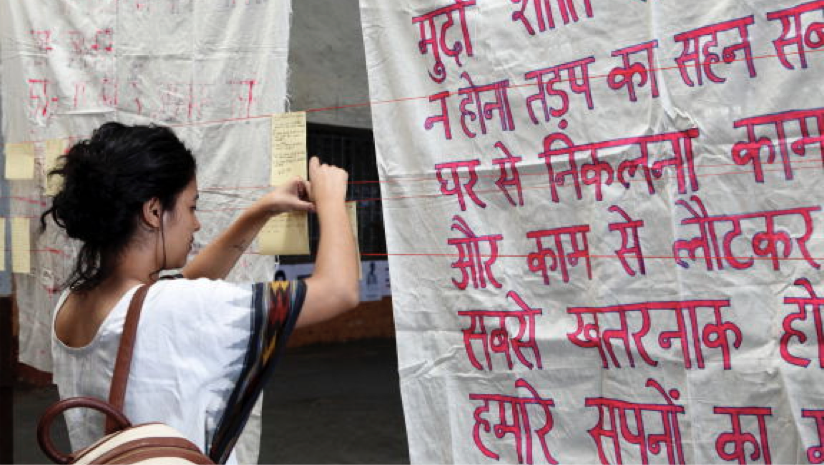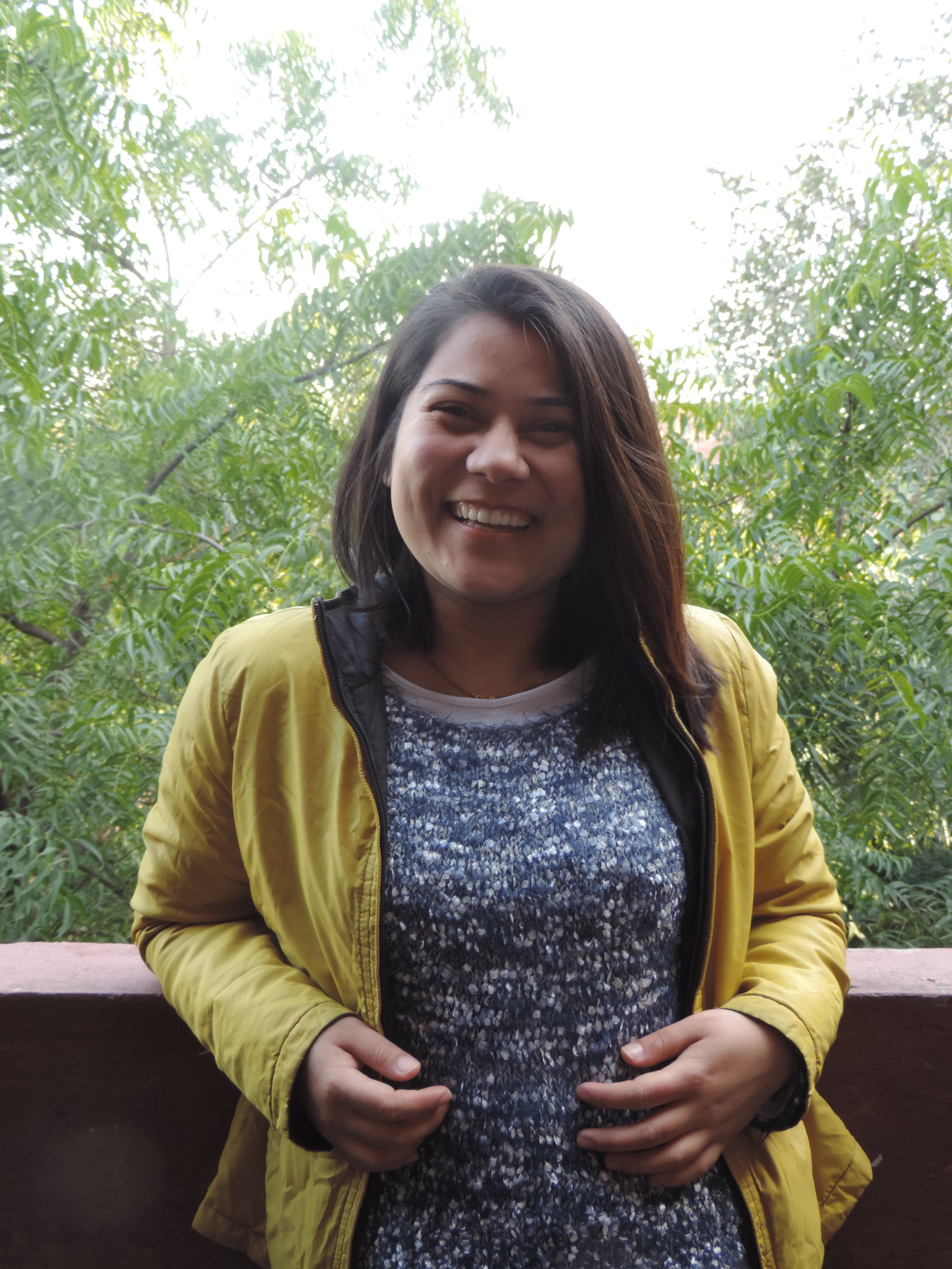Fine Art Awardees 2018
We're happy to welcome 2018's Fine Art Awardees.
Aqui Thami
My name is Aqui Thami. I’m a first generation indigenous artist and academic. My interest spans the fields of Anthropology of the State, Dalit & Indigenous Studies, Anti-racist Feminism, and Youth & Conflict Studies. My art is centered on the culture of DIY- self-publishing as well as the role of guerrilla posters. I believe in creating art that is grounded in the act of ‘doing’ and addresses political or social issues.
Working closely with the children and women in Dharavi and other neighborhoods facing systemic oppression since 2013, using art as a medium of story-telling, I’ve come to believe that art can truly empower. Apart from working in Dharavi Art Room, I am a part of Bombay Underground, a collective that experiments with various public art practices, including performance art. I am also pursuing a doctoral degree from the School of Social Work, Tata Institute of Social Sciences, Mumbai.
In the year 2015 I was nominated for the award Mumbai Heroes on the basis of my work with the women and children in Dharavi with the Dharavi Art Room. For my MPhil/PhD degree I was honored to receive a Maulana Azad National Fellowship as well as a Rajiv Gandhi National Fellowship awarded on the basis of academic ability. During my 2017 residency at the Darling Foundry, Montreal, Quebec, I am collaborating with Indigenous women in Canada and relooking at the concept of citizenship and nation.
In the coming year, I intend to work on creating a female-centered free library, with a resources network and community space. This is pivotal for engaging with the community and making art that is a form of political or social currency.
Khursheed Ahmad
I am currently pursuing a Master’s in Visual Arts from the School of Culture and Creative Expressions, Ambedkar University Delhi. Prior to this I received a Bachelor of Fine Arts degree in Painting from Kashmir University, Srinagar.
My artistic practice draws on several disciplines and mediums—performance, text, sounds, drawing, found objects and photography. Working across and between such mediums enables me to challenge the interaction between space, body, and language. In my practice, the body evokes differences in a space; language acts as a site of multiple contingencies; and the subject is navigated through different channels of thought and action.
The formal aspects of my work are tempered or broken down to strengthen its conceptual paradigms. This is best seen for instance in the way that elements of stammering form the conceptual background to probe the intricacies of the human condition deeper and relate to its various dimensions. Stammering becomes the common thread between me and my work, on the one hand relieving me from considering it as a handicap, and at the same time enabling me to unconceal the stammer/stutter/noise which is erased from the much cherished regularities of history.
Priyank Gothwal
My practice explores the limits of ‘stills’ (photography), along with all its genres such as archives, reprography and cinema graphs. Through extensive readings on the subject my works follow a philosophical inquiry of subtle monotonous and homogeneous motion of time, and incommensurable distances. For instance, if you are reading a passage or a verse, you often gaze thoughtfully into the far distance. Does that passage become a means and measure of that distance? If yes, then what is the limit of that gaze in time and space? Or if that passage in itself is the destination of that gaze, then what is the distance that lies in between? In other words, how do time and distance exist in an individual’s subjective/personal perception?
Taking this into account, I attempt to measure the witnessing of things; in other words, to understand what it means to look, to while away, to fade, to retrospect, to obsess over the sights that lie before us for the sake of the sight beyond, before realizing oneself as being finite and limited to existence.
My practice enables me to visually experience and decipher the language of time by witnessing collateral sufferings of the land as it calibrates itself in the spatially arranged patterns of distances by following the residual footprints left behind.
Priyanka Das
My interest lies in objects and environment which surround me, and in turn lead me to discover my identity. My works dwell on memories that disturb me. My artwork is an expression of my inner-most thoughts and traumas. I wear a mask of happiness so I do not become the subject of sympathy surrounding the dark truths that lie inside me. I silently face my demons through my practice without revealing too much. I use objects to represent my body metaphorically and generate a sense of curiosity in my viewers.
My artworks demonstrate the conflicts between myself and society. They showcase how a moment of vulnerability can change things. My illustrations on paper as well as my installations are intended to communicate with the viewer. I want the viewer to interact with my work. Even though I do not necessarily create interventions, it is sometimes difficult to focus on my works as they are installed in confined spaces. This leads to a sense of turmoil within myself, which is a reflection on what is being done or what shouldn’t be done in society.
My practice also looks at the idea of tangible and intangible connections within the spaces we inhabit through sight, sound, touch and even smell. I create detailed sketches of parts of the body, reminiscent of x-rays – not as a replication of the body, but rather as fragmented layers and deconstructed anatomy. I want to remove any sense of gender from my renderings and look at the body objectively.
My practice is a result of overcoming a difficult past, while still battling with a challenging present.
Shreya Shukla
My work is centered around an enquiry of the human body and its transition, both literally and metaphorically.
Initially, when I started dealing with this language of portraiture and figurative art, I was merely using the image of a body for self confrontation purposes.
I was always overwhelmed by the idea of the body and sexuality. Being physically awkward, I often think about the idea of touch and the vulnerability of the body. In order to become comfortable within my own skin, I indulged in the practice of self-documentation and self-study and made several self-portraits and studies of my own body, with the aim of de-eroticizing through distortion. Since then I've been working with self-centered narratives.
In my current body works I am trying to move out of certain mannerisms I had in my previous studies. In most of the works, like the object drawings or the 'hand in mouth' series, I am trying to associate fragmented text taken from several sources to an image that is not directly related to the image but acts as a parallel narrative, as a trigger and as an entry point to the work.
















